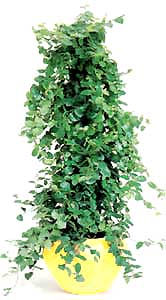Icicus / Ficus
Refers to the mulberry family.
General description: Ficus is one of the popular indoor plants. He owns clustered and ampel forms. Its dimensions range from large trees to ground cover plants.
Usually in the room conditions the following species are bred:
Ficus elastica (Ficus elastica). This is the most common species possesses several varieties, differing in shape and color of the leaves. Its leaves are very large, leathery, bright, on long cuttings. This is a large tree-like plant.
Ficus benjamina (Ficus Benjamin) is a tree-like ficus with drooping branches and pointed leaves, which are much smaller than the previous species. And owns spectacular variegated forms.
Ficus lirata (Ficus lyrate) is a tree-shaped ficus with large leaves in a form resembling a violin. They have wavy margins and a wax coating.
Ficus lirata pumila. This is an ampel fast-growing species. Has thin, wire-like stems and thin heart-shaped leaves up to 2.5 cm long.
Recommendations for caring for the plant Ficus:
Illumination : Tree-shaped fig trees need bright, but diffuse light, other species prefer partial shade.
Irrigation regime : For tree-shaped ficuses, moderate, by the measure of drying of the soil. In the winter, outlandish. Ampel forms are watered more often, but similar to carefulness. To water with warm soft water.
Humidity of air : Periodic spraying with warm water is desirable, especially for ampel forms. Keep away from drafts.
Temperatures : Moderate, in winter minimum 12 ° C.
Soil : Recommended soil mixture: 2 leaf elements, 1 share of peat land and 1 share of humus.
During the growth period, it needs fertilizing once every 2 weeks with liquid complex fertilizers ("Giant", "Rainbow" "Ideal", etc.)
Breeding : In the summer, in the soil heating and using phytohormones, the apical and leaf cuttings root. Tree ficuses are similar to air layers.
Transplantation : Transplanted in the spring, at what time the pot is made tight (the roots begin to germinate through the drainage holes). But annually replace the upper layer of the earth.
Pests : Shields are attacked (brown leaves appear on leaves and stems, leaving sticky excretions), thrips (grayish dots appear on the leaves).
The plant is allowed to help finish with a soap solution, warm washing and spraying with an actinic (1-2 ml per liter of water).



Ficus rubber - f. Elastica
Ficus benjamin - f. Benjamina
Ficus lyrate - f. Lirata
Ficus pygmy - f. Pumila


Comments
When commenting on, remember that the content and tone of your message can hurt the feelings of real people, show respect and tolerance to your interlocutors even if you do not share their opinion, your behavior in the conditions of freedom of expression and anonymity provided by the Internet, changes Not only virtual, but also the real world. All comments are hidden from the index, spam is controlled.